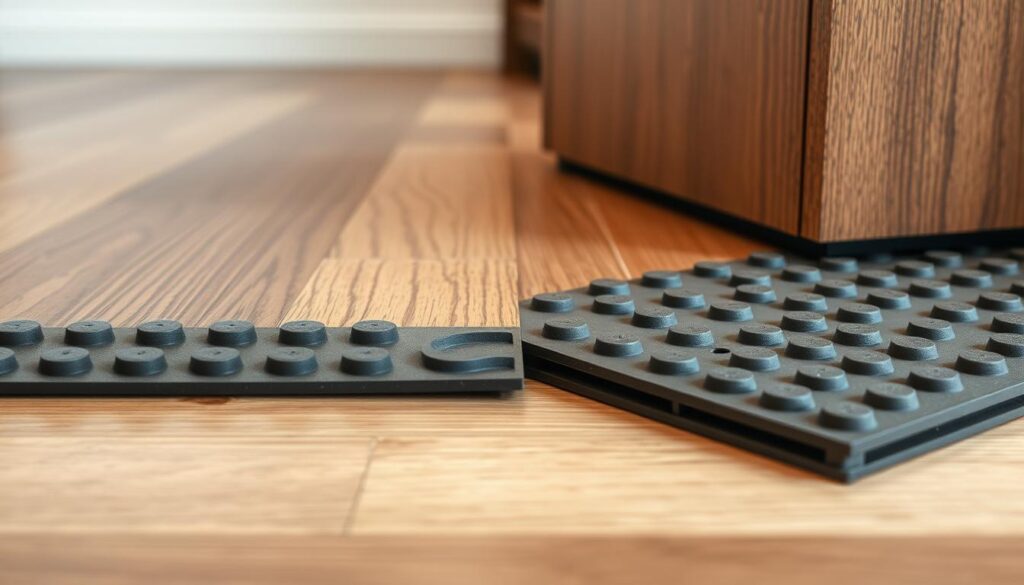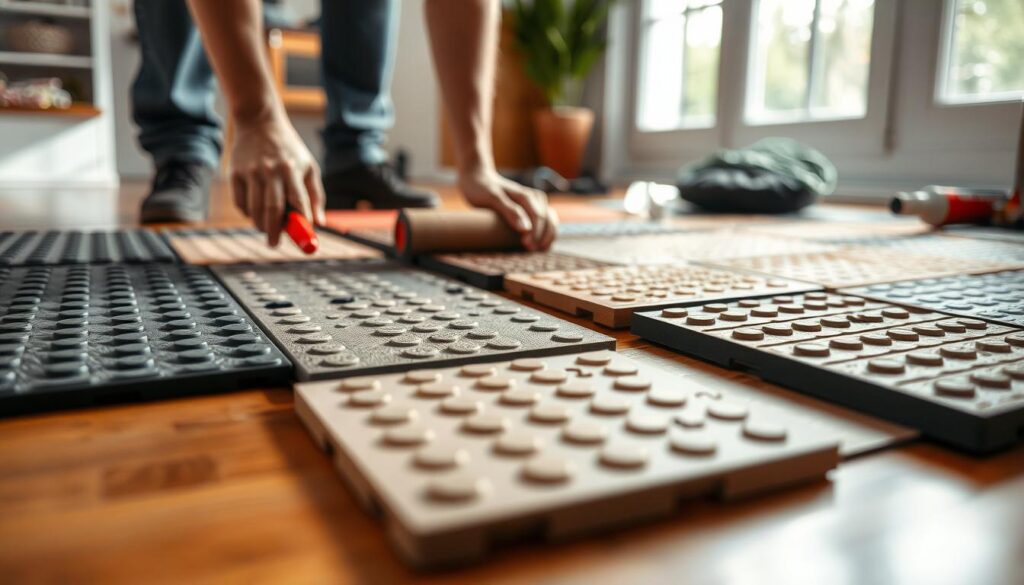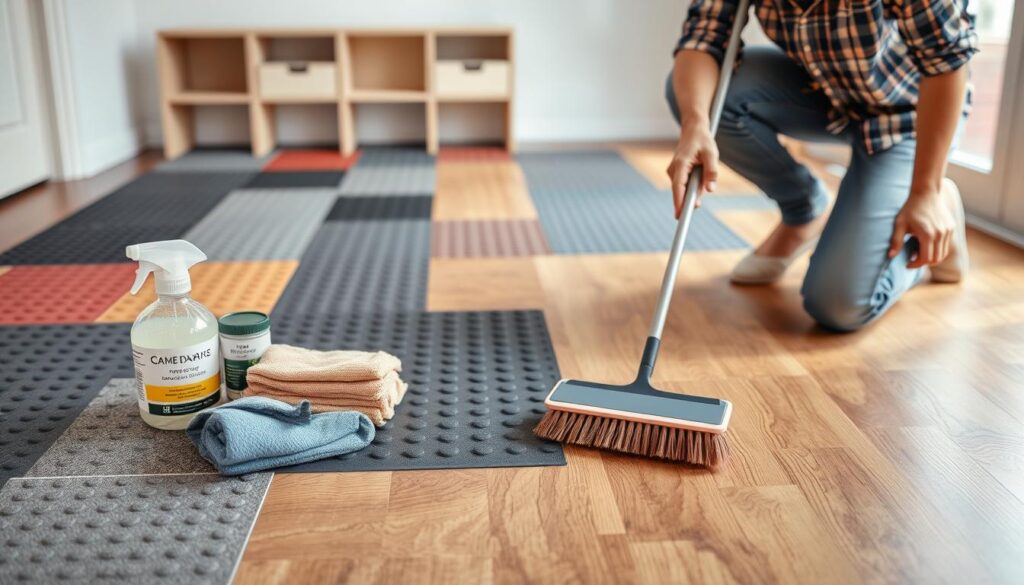Discover the ideal rubber flooring thickness to prevent damage to hardwood underneath. Get expert tips on selecting the right measurements to protect your investment
Keeping your hardwood floors safe is key, and thick rubber flooring is a great way to do it. This guide will show you the best thickness for rubber flooring to protect your floors. We’ll look at the types of rubber flooring, their benefits, and what to consider when choosing the right thickness for you.

Key Takeaways
- Understand the different types of rubber flooring and their protective capabilities
- Discover the advantages of using rubber over other flooring materials
- Learn the minimum thickness requirements to effectively safeguard your hardwood floors
- Explore the installation methods for seamless integration with your existing hardwood floors
- Analyze the cost considerations and long-term value of thick rubber flooring solutions
By the end of this guide, you’ll know how to pick the best thick rubber flooring for your hardwood floors. Contact us at +6282332572828 or info@timbertropics.com for help and expert advice.
Understanding Rubber Flooring as Protective Layer for Hardwood
Keeping your hardwood floors safe is key, and rubber flooring is a great choice. It comes in many forms, like rolls, tiles, and mats. These are made to protect your floors from damage and wear.
By looking at the different rubber floor options, you can pick the best one for you. This ensures your floors stay in top shape.
Types of Rubber Floor Protection Available
- Rubber floor rolls: Continuous sheets of rubber that can cover large areas seamlessly
- Rubber floor tiles: Modular, interlocking tiles that provide flexibility in layout and installation
- Rubber floor mats: Smaller, portable solutions for targeted protection in high-traffic zones
Benefits of Using Rubber Over Other Materials
Rubber flooring is known for its toughness, cushioning, and slip resistance. It’s more durable than foam or vinyl, making it better for protecting your floors. It also absorbs shock well, preventing damage from heavy items.
Common Applications in Different Settings
Rubber flooring works well in many places. In home offices, it protects floors from moving chairs. Gyms and studios use it for its grip and shock absorption. Industrial areas prefer it for its durability and look.
To learn more about rubber flooring for your hardwood, call Timber Tropics at +6282332572828 or email info@timbertropics.com. Our team will help you choose the right rubber flooring for your space.
Essential Factors in Choosing Rubber Floor Thickness
Choosing the right rubber floor thickness is key to protecting your hardwood floor. Several important factors should guide your choice. Let’s look at what you need to consider.
Foot Traffic and Usage
The amount of foot traffic and activities in your space affect the needed rubber floor thickness. Places with lots of people, like offices or busy homes, need thicker rubber. This provides better cushioning and lasts longer.
Equipment and Weight Considerations
Heavy equipment or furniture on your rubber floor means you need a thicker layer. Thicker rubber can handle more weight. This helps prevent damage to your hardwood floor.
Noise Reduction Requirements
Rubber floors are great at reducing noise. The thicker the rubber, the better it absorbs sound. This is very useful in places like home gyms or exercise rooms.
| Rubber Floor Thickness | Suitable Applications |
|---|---|
| 1/8 inch (3 mm) | Light-duty residential, office spaces |
| 1/4 inch (6 mm) | Medium-duty commercial, light industrial |
| 1/2 inch (12 mm) | Heavy-duty commercial, industrial, gyms |
Think about these rubber floor thickness factors and flooring selection criteria when choosing. This ensures your hardwood floor is well-protected and meets your needs. For personalized advice, call us at +6282332572828 or email info@timbertropics.com.
https://youtube.com/watch?v=3PedEZ8pZOk
How Thick Rubber Flooring to Prevent Damage to Hardwood Underneath
Protecting your hardwood floors is key, and rubber flooring thickness plays a big role. The right thickness can shield your floors from damage. This includes heavy foot traffic, furniture movement, and other hazards. Let’s look at how to choose the best rubber flooring thickness to protect your hardwood.
Minimum Thickness Requirements
The minimum thickness for rubber flooring over hardwood is 1/8 inch (3 mm). This thickness offers basic cushioning and impact resistance. It helps prevent scratches, dents, and other damage. But, for areas with lots of traffic or heavy use, a thicker rubber floor might be better.
Maximum Weight Capacity by Thickness
The thickness of your rubber flooring affects how much weight it can handle. A 1/4 inch (6 mm) thick floor can support up to 500 pounds per square foot. A 3/8 inch (10 mm) floor can handle up to 800 pounds per square foot. For very heavy use, like in home gyms or commercial spaces, choose a 1/2 inch (12 mm) or thicker floor.
Impact Resistance Specifications
The impact resistance of your rubber flooring is also important. Look for rubber with a Shore A hardness rating between 60 and 90. This shows it can handle heavy impacts without deforming. This helps prevent dents, cracks, and other damage to your hardwood floors.
Knowing the minimum thickness, weight capacity, and impact resistance helps you choose the right rubber flooring. This protects your hardwood floors and keeps them looking great for years. For more advice or to see our rubber flooring options, call us at +6282332572828 or email info@timbertropics.com.
Installation Methods for Rubber Flooring Over Hardwood
Rubber flooring is a great way to protect your hardwood floors. The installation method depends on your space’s needs. Let’s look at the rubber flooring installation methods and how they protect your hardwood floor protection techniques.
Loose-Lay Rubber Flooring
Loose-lay rubber flooring is easy to use. You place the tiles or rolls on your hardwood floor without adhesives. The rubber’s friction and weight keep it in place. It’s perfect for busy areas or where you might need to access the hardwood later.
Adhesive-Backed Rubber Flooring
Adhesive-backed rubber flooring is a more permanent choice. You apply a special adhesive to the hardwood, then press the tiles or rolls into place. This method gives a strong bond, protecting your hardwood from damage.
Interlocking Rubber Flooring
Interlocking rubber flooring has a tongue-and-groove design. The tiles or planks snap together, making a smooth surface. It’s easy to install and can be taken apart if needed. This makes it great for different settings.
Choosing the right rubber flooring installation is key. Proper preparation and following the manufacturer’s instructions are crucial. With the right method, you can keep your hardwood floors beautiful for years.
“Protecting your hardwood floors with the right rubber flooring installation is a smart investment that can save you time and money in the long run.”

For more information or to discuss your needs, contact us at +6282332572828 or info@timbertropics.com. Our experts are ready to help you find the best rubber flooring installation for your hardwood floor protection.
Cost Analysis of Thick Rubber Flooring Solutions
Choosing thick rubber flooring for your hardwood floor protection has different costs. It’s important to look at the initial cost, long-term value, and compare prices. This helps you choose the right option for your budget and needs.
Initial Investment Considerations
The cost of thick rubber flooring changes based on size, brand, and thickness. You might spend $5 to $15 per square foot for top-quality flooring. Think about this cost against the long-term benefits of protecting your hardwood floors.
Long-term Value and Maintenance Costs
The rubber flooring cost might seem high, but it’s worth it in the long run. Rubber flooring is durable and needs little upkeep. This can save you money on repairs and refinishing your hardwood floors later.
Just clean it regularly and do spot treatments now and then. This keeps your rubber floor looking great for many years.
Price Comparison by Thickness
| Rubber Flooring Thickness | Average Price per Sq. Ft. | Maximum Weight Capacity |
|---|---|---|
| 1/8 inch | $5 – $8 | 200 lbs/sq. ft. |
| 1/4 inch | $8 – $12 | 300 lbs/sq. ft. |
| 1/2 inch | $12 – $15 | 500 lbs/sq. ft. |
Thicker rubber flooring costs more but offers better protection and can hold more weight. Think about your needs and budget to pick the right thickness for your hardwood floor.
For personalized advice on your rubber flooring cost and investment, call us at +6282332572828 or email info@timbertropics.com. Our experts are ready to help you choose the best option for your space.
Maintaining Your Rubber Floor Protection System
It’s key to keep your rubber floor protection system in great shape. Regular rubber floor maintenance and hardwood protection care help your floors last longer. They also keep your floors looking their best. Here are some easy tips to keep your rubber flooring in top condition and protect the hardwood underneath.
Cleaning and Caring for Rubber Flooring
Using the right cleaning methods is vital for your rubber floor’s look and function. Sweep or vacuum it often to get rid of dirt and debris. For a deeper clean, use a mild cleaner and a soft-bristle brush or mop. Stay away from harsh chemicals or abrasive scrubbers that can harm the rubber.
Preventative Measures for Hardwood Protection
- Check the rubber flooring often for wear or damage and fix it right away.
- Use transition strips or trim to protect the edges of the rubber flooring from lifting or peeling.
- Don’t drag heavy furniture or equipment across the rubber floor to avoid making dents or tears.
- Use furniture pads or glides to prevent scratches or dents on the hardwood underneath.
Extending the Lifespan of Rubber Flooring
With the right care, your rubber floor protection system can last a long time. Follow the maker’s advice for cleaning, sealing, and maintenance. This ensures your rubber flooring works well for a long time. By taking care of your rubber floor maintenance and hardwood protection care, you’ll get the most out of your investment. Your floors will stay beautiful and well-protected for many years.
| Maintenance Task | Frequency |
|---|---|
| Sweep or vacuum | Daily or as needed |
| Damp mop with pH-neutral cleaner | Weekly or biweekly |
| Inspect for wear or damage | Monthly |
| Reseal or recoat (if applicable) | Every 1-2 years |

“Investing in proper rubber floor maintenance and hardwood protection care is a smart way to safeguard your floors and maximize the value of your investment.”
Common Mistakes to Avoid When Installing Rubber Flooring
Installing rubber flooring right is key to its lasting quality. Even pros and DIYers can make mistakes. Knowing these common errors can help you have a great installation:
Surface Preparation Errors
Not cleaning and preparing the subfloor well can cause problems. Make sure the floor is clean and even before you start. Fix any cracks or uneven spots first.
Thickness Selection Mistakes
Choosing the wrong thickness can harm your hardwood floors or make the rubber unstable. Check the manufacturer’s advice and think about how much traffic and weight it will get. This will help you pick the right thickness.
Installation Technique Problems
Bad cutting, seaming, or using the wrong adhesive can ruin your flooring. Always follow the manufacturer’s instructions. If you’re not sure, get help from a pro.
Avoiding these rubber flooring installation errors and flooring mistakes will make your flooring last longer. For top-notch advice and products, reach out to Timber Tropics at +6282332572828 or info@timbertropics.com.
| Mistake | Description | Consequence |
|---|---|---|
| Surface Preparation Errors | Failing to clean and level the subfloor | Uneven surfaces, poor adhesion, premature wear |
| Thickness Selection Mistakes | Choosing the wrong rubber flooring thickness | Inadequate protection or unstable, unsupported surface |
| Installation Technique Problems | Improper cutting, seaming, or adhesive application | Compromised stability and long-term performance |
Environmental Impact and Sustainability Factors
Choosing the right flooring material is key for eco-friendly home upgrades. Eco-friendly rubber flooring is a great option. It protects your hardwood floors and helps the environment. Unlike other options, sustainable floor protection from rubber has many benefits.
Rubber flooring often uses recycled materials. This cuts down on the need for new materials and keeps waste out of landfills. Also, it has low VOC emissions, making your home air healthier. When it’s time to replace it, rubber can be recycled or reused.
By picking eco-friendly rubber flooring, you help the planet and keep your floors looking good. This choice is good for your home and the future. For more details, call us at +6282332572828 or email info@timbertropics.com.
“Choosing sustainable flooring solutions is a simple yet impactful way to reduce your carbon footprint and create a healthier living environment.”
Comparing Different Rubber Flooring Brands and Materials
Choosing the right rubber flooring brand and material is crucial for protecting your hardwood floors. Let’s look at some top rubber flooring options and compare their features.
| Brand | Material | Durability | Price Range | Warranty | Customer Satisfaction |
|---|---|---|---|---|---|
| Lumber Liquidators | Recycled Rubber | High | $3-$8 per sq ft | 5-7 years | 4.5/5 |
| Rubber-Cal | Virgin Rubber | Extremely High | $5-$12 per sq ft | 10 years | 4.7/5 |
| Greatmats | Hybrid Rubber | Very High | $4-$10 per sq ft | 7-10 years | 4.8/5 |
There are many quality rubber flooring brands out there. Each offers a mix of materials, durability, and warranty. Your budget, desired thickness, and the area’s traffic will guide your choice.
“Investing in the right rubber flooring can save you from costly hardwood floor repairs down the line.”
For a good choice, talk to flooring installers or retailers for advice. The right rubber flooring protects your hardwood floors for years.
Professional Installation vs DIY: Making the Right Choice
Choosing between professional installation and DIY for thick rubber flooring is a big decision. Each option has its own pros and cons, from tools and materials to time and cost. Let’s look at the key factors to help you decide.
Tools and Materials Needed
For DIY rubber flooring, you’ll need a utility knife, rubber mallet, trowel, and straight edge. You’ll also need rubber flooring, adhesive, and underlayment or edge trim. Having the right tools and materials is key for a successful DIY project.
Time and Cost Considerations
Time and cost vary between professional and DIY installation. Professionals can finish the job quickly, often in a day or two. But, this speed comes with a higher cost. DIY takes longer, but can save money on labor.
Protecting your hardwood floors with rubber flooring is a smart choice. Whether you go for professional installation or DIY, it’s a great way to keep your floors looking good. Contact Timber Tropics at +6282332572828 or info@timbertropics.com for advice and a personalized recommendation.
FAQ
What are the different types of rubber flooring available to protect my hardwood floor?
You can pick from rolls, tiles, and mats for rubber flooring. Each type is made to protect your hardwood floors. The right choice depends on your needs and the space’s setup.
What are the benefits of using rubber flooring over other materials to protect my hardwood floor?
Rubber flooring is durable and absorbs impacts well. It also reduces noise. These features make it great for protecting your hardwood floors from heavy use.
Where can I commonly find rubber flooring used to protect hardwood floors?
Rubber flooring is used in gyms, offices, and industrial areas. It’s a practical choice for places with lots of activity or heavy equipment.
What factors should I consider when choosing the ideal thickness of rubber flooring to protect my hardwood floor?
Think about foot traffic, equipment weight, and noise needs. The right thickness depends on your environment and how you use the space.
What is the recommended minimum thickness of rubber flooring to prevent damage to my hardwood floor?
A minimum of 1/4 inch (6mm) is recommended. This thickness cushions impacts and spreads weight evenly, protecting your hardwood.
How much weight can different thicknesses of rubber flooring support before causing harm to my hardwood floor?
Thickness affects weight capacity. For example, 1/4 inch (6mm) supports up to 250 lbs/sq ft. 3/8 inch (10mm) can handle up to 500 lbs/sq ft.
What impact resistance specifications should I look for in rubber flooring to ensure optimal protection for my hardwood floor?
Look for high impact resistance ratings. A minimum of 70% impact attenuation is best. This ensures your hardwood is safe from heavy impacts.
What are the different methods for installing rubber flooring over my hardwood floor?
You can install rubber flooring with loose-lay, adhesive, or interlocking systems. Choose based on your space, preferences, and skills.
What are the initial investment and long-term maintenance costs associated with thick rubber flooring solutions to protect my hardwood floor?
Initial costs vary by thickness, quality, and installation. But, rubber flooring is cost-effective in the long run, with lower maintenance costs.
How do I properly maintain my rubber floor protection system to ensure it continues to safeguard my hardwood floor?
Regular cleaning and using approved products are key. Also, place mats at entryways to reduce dirt and debris.
What are some common mistakes to avoid when installing rubber flooring to protect my hardwood floor?
Avoid bad surface prep, wrong thickness, and poor installation. Follow best practices and manufacturer guidelines for a successful installation.
How can I ensure that the rubber flooring I choose is environmentally friendly and sustainable?
Look for products with recycled content, low VOCs, and recyclability. Sustainable options help make your space greener.
How do the different rubber flooring brands and materials compare in terms of durability, price, and customer satisfaction?
Many brands and materials are available, each with unique features. Research durability, price, warranty, and reviews to find the best fit for your needs.
Should I consider a professional installation or attempt a DIY approach for my rubber flooring to protect my hardwood floor?
Decide based on tools, time, cost, and your skills. Weigh the pros and cons of each option to choose the best for your project.
Related article : Brazilian Cherry Hardwood Flooring: Premium Wood Options
